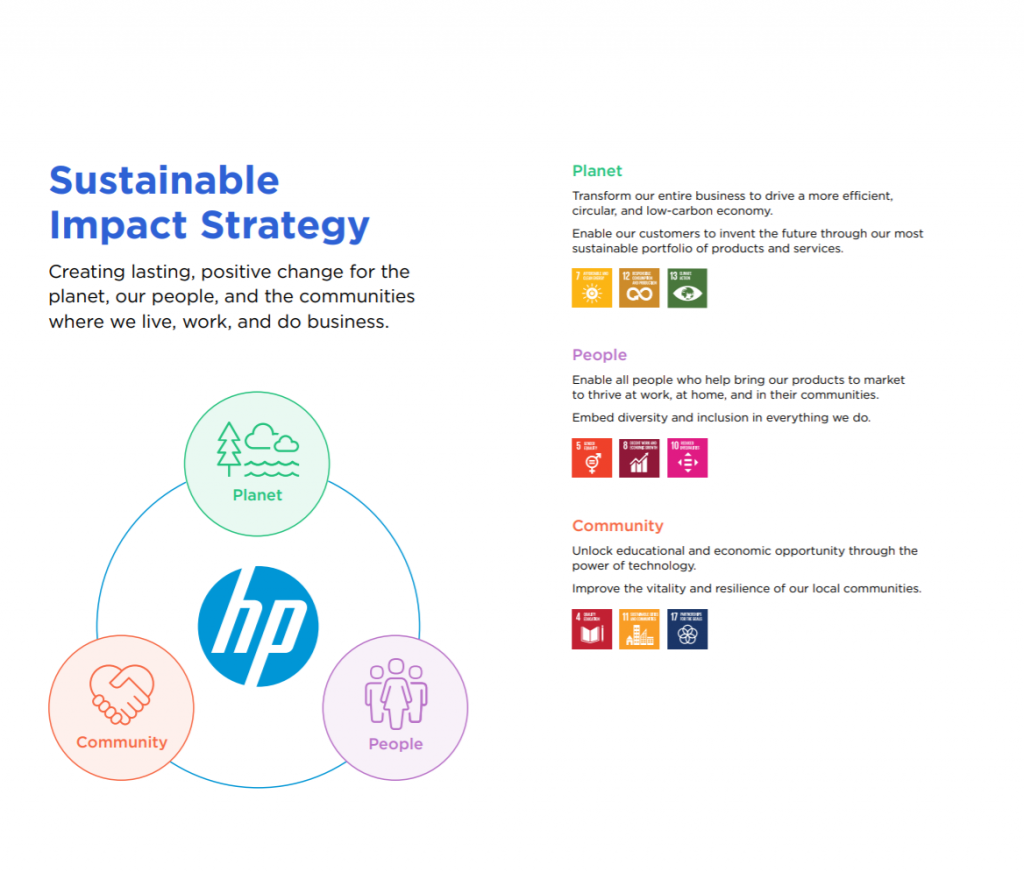“One of the first conditions of happiness is that the link between man and nature shall not be broken.”- Leo Tolstoy
On April 20, 2021, just a couple of days before Earth Day – April 22, HP announced “some of the most aggressive and comprehensive goals in the tech industry to combat #climatechange.”
‘Sustainable Impact’ is HP’s guiding principle for delivering on its corporate vision – to create technology that makes life better for everyone, everywhere. In this fifth article on the Sustainable Brand Strategies in the series of six, let’s explore how HP is making an impact with sustainable practices for a better earth.
It is not the first time HP showed commitment to environmental sustainability and a dedication to UN Sustainable Development Goals. In 2020, HP announced that it has the world’s most sustainable PC Portfolio. This claim is based on the criteria set out by EPEAT—the most comprehensive, measurable, and transparent eco-label in the IT industry.
HP Elite c1030 Chromebook Enterprise laptop is the world’s first Chromebook with ocean-bound plastic, contains 75 percent recycled aluminum in its top lid, and has a keyboard made from 50 percent recycled plastics.
This Chromebook joins a series of HP personal systems products made with ocean-bound plastic, including the HP ZBook Studio, the world’s first mobile workstation with ocean-bound plastics; the HP Elite Dragonfly, the world’s first notebook made with ocean-bound plastic, and the HP Elite Display E273D, the world’s first display manufactured using ocean-bound plastic.
Sustainable Impact Strategy of HP:
HP Inc. is a well-established name in the world of IT products, services, and supplies. It is interesting to notice that HP’s sustainability strategy extends beyond products. It is built to drive impact across three pillars – Planet, People, and Community that resonate with three essentials of sustainability strategy – environmental, economic, and social impact of business.
The time and efforts that HP has invested in developing the sustainability strategy and reporting its year-on-year impact to reflect the company’s commitment towards a sustainable environment and better life for all.

- Print and Compute-as-a-Service: Print supplies renewal, hardware-as-a-service, certified pre-owned.
- Sustainable materials: Increase use of renewable and recycled materials
- Supply chain decarbonization: Drive and support supplier carbon reduction, use of renewable electricity, and adoption of surface transportation and alternative fuels and electric vehicles for product shipments
- Energy efficiency: Design in existing and new energy-efficient product technologies
- Forest investments: Address the fiber used in printing and packaging by investing in forest restoration and protection, and continue to source certified or recycled materials
True to the spirit of a tech company, the strategy is informed by analysis of megatrends, materiality assessment, ongoing engagement with stakeholders, and alignment with HP’s businesses.
The Action Plan and Results:
To generate results aligned to its strategy, HP has pursued a comprehensive action plan over the years. It runs multiple programs and partnerships to achieve its mission.
To combat ocean plastic pollution and improve lives, HP has sourced more than 60M plastic bottles of ocean-bound plastic for use in new HP products. It also spearheads a Sustainable Forests Cooperative, which goes beyond sustainable fiber sourcing programs. It is designed to drive action now and inspire others to preserve and improve forest ecosystems for future generations.
HP aimed to achieve zero deforestation associated with HP brand paper and paper-based product packaging by 2020. It was achieved 100% for brand paper way back in 2016, 80% for paper-based product packaging in 2019, and numbers for packaging are due to arrive in Sustainable Impact Report 2020.
HP is involved in dedicated efforts to eliminate forced labor, promote workers’ wellbeing, health, safety, and protect workers’ rights. The company champions respect for human rights with policies and due diligence.
HP is accelerating the efforts through the HP Racial Equality and Social Justice Task Force to meet the Diversity, Equity, and Inclusion goals, This task force is focused on three goals associated with employees:
- Double the number of Black and African American executives by 2025
- Double Black and African American promotion rates and technical representation by 2025
- Achieve 90% (up from 84%) in inclusion index score for Black and African American employees in 2021
HP Canada was recently recognized as one of Canada’s best diversity employers.
To further its efforts in community building, HP taps into its employees’ talents, passions, and entrepreneurial spirit to make a difference. HP employees are granted four hours of paid volunteer time per month.
In 2019, 8,850 employees contributed about 145,000 hours to local volunteer efforts in 51 countries, with a value of $5.43 million.
HP LIFE by HP Foundation is focused on developing a skilled workforce. It provides business and 21st-century skills to entrepreneurs, small business owners, and lifelong learners. The HP Refresh is another commendable project. It helps communities crowdsource computers for donations to schools.
In additional efforts, HP is enabling its partners and employees to drive lasting impact. Recently it unveiled – HP Amplify Impact. Under this program, every HP employee is encouraged to set a sustainable impact goal as part of their FY21 goal-setting process.
Essentially, HP is empowering a 55,000-person sustainable impact team within the company. Partners that pledge to join the HP Amplify Impact program will work with HP to assess their own practices while tapping into its extensive investments and initiatives.
Revenue Strategy:
Though the revenue aspect of sustainability strategy would need an article of its own, it is safe to say that all these sustainability efforts are not just philanthropic. On the business and revenue front, HP’s Sustainable Impact efforts helped drive more than US$1 billion in sales wins in 2020 for the second year in a row.
For the past two years, under the leadership of HP’s CEO Enrique Lores, sustainable impact targets, including diversity, equity, and inclusion, have been part of the annual performance evaluation for HP’s executive leadership team.
Performance against these sustainable impact targets and other business objectives is tied to their total compensation, making it as essential as any other business component.
Conclusively, it will not be an exaggeration to say that over the past 80 years, HP continuously focused on purpose as an essential component of its business strategy. As a result, now it is way ahead of many of its competitors in the drive for socio-economic development and #climatechange.
What can brands learn?
- Include sustainable goals in your core business strategy and not as an afterthought.
- If in doubt about where to start, use UN Sustainable Development goals as your guiding principles.
- Find innovative and financially rewarding ways to empower employees for setting personal sustainability goals.
- Measure every small initiative that your brand takes in the direction of creating a better world.
- Capitalize on your partnerships to set and achieve goals.
Feel Free to read the full HP Sustainable Impact Report 2019 here.
This article was 5th in a series of 6 articles by the author to focus on sustainability strategies and impact of global brands. Check out the first four below:
1st story: Be human. Be well. Be planet. Lululemon’s Sustainability Strategy
2nd story: Sustainable Cocoa. Delicious Chocolates. Lindt & Sprüngli
3rd Story: SheEO: Impact of Radical Generosity! A New Model. A Better World.
4th Story: Sustainability & Impact Design. Grassroot by Anita Dongre
-AMAZONPOLLY-ONLYWORDS-START-
Also, check out our most loved stories below

Why did Michelin, a tire company, decide to rate restaurants?
Is ‘Michelin Star’ by the same Michelin that sells tires, yes, it is! But Why? How a tire company evaluations became most coveted in the culinary industry?

Johnnie Walker – The legend that keeps walking!
Johnnie Walker is a 200 years old brand but it is still going strong with its marketing strategies and bold attitude to challenge the conventional norms.

Starbucks prices products on value not cost. Why?
In value-based pricing, products are price based on the perceived value instead of cost. Starbucks has mastered the art of value-based pricing. How?

Nike doesn’t sell shoes. It sells an idea!!
Nike has built one of the most powerful brands in the world through its benefit based marketing strategy. What is this strategy and how Nike has used it?

Domino’s is not a pizza delivery company. What is it then?
How one step towards digital transformation completely changed the brand perception of Domino’s from a pizza delivery company to a technology company?

BlackRock, the story of the world’s largest shadow bank
BlackRock has $7.9 trillion worth of Asset Under Management which is equal to 91 sovereign wealth funds managed. What made it unknown but a massive banker?

Why does Tesla’s Zero Dollar Budget Marketing Strategy work?
Touted as the most valuable car company in the world, Tesla firmly sticks to its zero dollar marketing. Then what is Tesla’s marketing strategy?

The Nokia Saga – Rise, Fall and Return
Nokia is a perfect case study of a business that once invincible but failed to maintain leadership as it did not innovate as fast as its competitors did!

Yahoo! The story of strategic mistakes
Yahoo’s story or case study is full of strategic mistakes. From wrong to missed acquisitions, wrong CEOs, the list is endless. No matter how great the product was!!

Apple – A Unique Take on Social Media Strategy
Apple’s social media strategy is extremely unusual. In this piece, we connect Apple’s unique and successful take on social media to its core values.
-AMAZONPOLLY-ONLYWORDS-END-

















